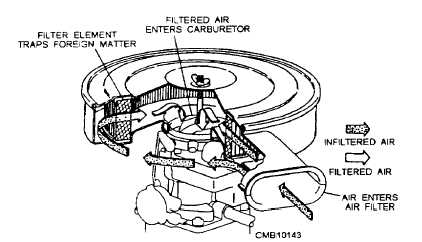
Figure 4-14. - Air cleaner.
Route all fuel lines and hoses away from hot or moving parts. Double-check the clearance after installation.
Only use approved synthetic rubber hoses in a fuel system. Vacuum hose is NOT to be used as fuel hose.
Make sure fuel hoses completely cover its fitting or line before installing clamps. Pressure in the fuel system could force the hose off if not installed properly.
Double-check all fitting for leaks. Start the engine and inspect the connections closely.
NOTE Most fuel injection systems have very high fuel pressure. Follow recommended procedures for bleeding or releasing pressure before disconnecting a fuel line or fitting. This action will prevent fuel spray from possibly causing injury or a fire.
AIR CLEANER
The fuel system mixes air and fuel to produce a combustible mixture. A large volume of air passes through the carburetor or fuel injection system and engine, as much as 100,000 cubic feet of air every 1,000 miles. Air always contains a lot of floating dust and grit. The dust and grit could cause serious damage if they entered the engine. To prevent this, mount an air cleaner (fig. 4-14) at the air entrance of the carburetor or fuel injection system. The two types of cleaners currently used are the wet and dry types.
The wet-type. or oil bath, air cleaner consists of the main body, the filter element that is made of woven copper gauze, and the cover (fig. 4-15). Operation is as follows:
Incoming air enters between the cover and the main body. The air is pulled down to the bottom of the main body where it must make a 180-degree turn, as it passes over the oil reservoir.

Figure 4-15. - Wet-type air filter.
Continue Reading